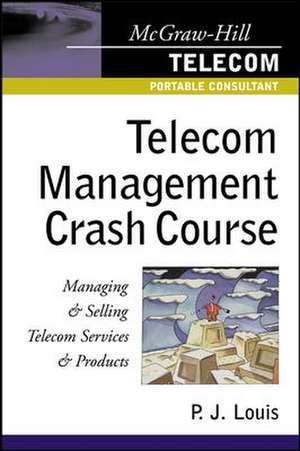Telecom Management Crash Course
Autor P. J. Louisen Limba Engleză Paperback – 15 iun 2002
The bubble has burst! The period of effortless, double-digit growth and skyrocking capitalization for telecom carriers is over. With many carriers struggling and stocks falling, the telecom industry has become more unforgiving, competitive, and cut-throat than ever. The market's long-term potential is still enormous, but success now requires a sharp business and technology savvy management team--and adherence to sound, hardheaded business management principles. That's what "Telecom Management Crash Course" is all about--it takes a functional business look at the fundamentals of successfully running a hardware manufacturing company, software development firm, and service provider.
A TRUE TELECOM TEXT FOR OUR TIME!
In "Telecom Management Crash Course," P.J. Louis, a top industry advisor and author of the wildly popular "M-Commerce Crash Course" shows telecom servers how to efficiently manage the technology advantages and back-end operations to survive--and prosper--in this challenging economic climate. He covers the business of telecom--everything from the various types of telecom companies to developing a product that the market can really use. Invaluable to executives, managers, and decision-makers at telecom carriers of all sizes, this much-needed resource is a veritable executive summary of how (and how not) to run a telecom business--and includes advice, tricks-of-the-trade, solutions, factual information, and strategies that can keep your busines afloat while others are sinking.
LOOK INSIDE TO LEARN:
* The best organizational structures
* Sales and marketing fundamentals
* How to evaluate themarketplace and the financial value of products and services
* The most effective management styles
* How to integrate technological and business objectives
* How to develop and implement market-driven strategy
* What you need to know about state and federal regulatory considerations
* How globalization affects every carrier
* Manufacturing and outsourcing techniques.
Preț: 241.08 lei
Nou
46.14€ • 50.10$ • 38.75£
Carte disponibilă
Livrare economică 01-15 aprilie
Specificații
ISBN-10: 0071386203
Pagini: 346
Dimensiuni: 150 x 226 x 24 mm
Greutate: 0.48 kg
Editura: McGraw Hill Education
Colecția McGraw-Hill Education
Locul publicării:United States
Cuprins
Preface
IntroductionAcknowledgments
CHAPTER 1: WHAT IS A TELECOMMUNICATIONS COMPANY?
Makers of HardwareMakers of Software
Providers of Service to the Hardware and Software Companies
Intellectual Property
Providers of Service to the User
Wireline Telephone Companies
Cellular (Wireless) Carrier
Personal Communications Services (PCS) Comapnies/Carriers
Paging Systems
Satellites
Cable Television Networks
Internet
Providing Service to Users (Selling Retail Telecommunications Services)
Providers of Service to Other Providers of Service
Perspective: Supplier and Customer
Why is the Carrier-Vendor Relationship Important?
Interdependency
The Culture
Telecommunications Professional and Telecommunications Manager
Summary
CHAPTER 2: ORGANIZATIONAL STRUCTURES
Classic Organizational StructureDecision-Control Process and Organizational Structure
Centralized Decision Making
Decentralized Decision Making
What is the Model to Follow for Telecommunications Companies?
Service Provider Decentralization Gone Wrong
Optimizing the Organizational Structure
Summary
CHAPTER 3: THE TELECOMMUNICATIONS SERVICE PROVIDER
Basic Organizational FunctionsWireless Telecommunications Carrier Organizational Functions
Wireless Carrier Organizational Functions
Internet Service Provider Organizational Functions
Carrier Organizational Structures
Vertical and Flat Organizational Structures
Departmentation
Product Departmentation
Functional Departmentation
Balancing Financial Objectives and Organizational Needs
Senior Management
General Counsel and Vice President of Legislative/Regulatory
Legislative Regulatory Area
Legal Group
Vice President of Public Relations
Example of Public Relations
Public Relations--Perception is Reality
Chief Technical Officer--Technology and Operations
Network Planning and Engineering
Strategic Network Planning
Network OperationsChief Financial Officer
Vice President of Information Technology (IT)
Vice President of Finance/Comptroller
Vice President of Sales and Marketing
Chief Operating Officer (COO)Vice President of Human Resources and Administration
Economic Downturn and the Role of HRA
Employee Benefits--Promoting the Company
Fiscal Accountability
Summary
CHAPTER 4: THE TELECOMMUNICATIONS VENDOR--HARDWARE, SOFTWARE, AND SERVICES
OutsourcingMultitude of Vendor Types--Impact on Organizational Structure
Basic Organizational Functions
Organizing the Vendor
Departmentation
Product Departmentation
Product Departmentation Diversification and Market Response
Vendor Organizations
Senior Management
Product Lines
The Process of Creation
The Creative Process--Organized Creation and Creative Management
The Creative Process--Product Management
Example of Product Management Process
Product Management: Mediation, Facilitation, Coordination--Hitting the Mark
Product Definition
The Four Ps
Product Life Cycle
Contract Signing
Vendor Organization Requirements
Summary
CHAPTER 5: STRATEGY, TACTICS, AND SHARED VALUES
Strategic PlanningMarket Segment and Size
Value: The Story
Value: The Product's/Service's Intrinsic Value
Value: The Value Proposition
Distribution
Distribution: Sales
Distribution: Marketing the Product
Distribution: Warehousing and Delivering the Product
Scope and Scale of Execution
Tactical Planning
Binding Strategy and Tactics: The Vision
Where Do Vision, Strategy, and Tactics Lead the Company?
Summary
CHAPTER 6: MARKET FOCUS--UNDERSTANDING THE TELECOMMUNICATIONS MARKET
Retail Telecommunications Services MarketplaceResidential
Business
Government
Wholesale Telecommunications Marketplace
Types of Wholesale Services
Market Focus
Market Segmentation
Steps in Segmentation
Identify Potential Segments
Select Segments
Test for Strategic Relevance
Measurability
Market Driven versus Sales Driven
Summary
CHAPTER 7: DEVELOPING MARKET DRIVEN STRATEGIES--HOW?
Adaptive Planning--Organizing Management Thought ProcessesAssessment
Strategic Analysis
Decision Making
Implementation--The Final Phase
Implementation--The Customer View
Implementation--The Complete View
Resetting the Strategy
Summary






















